The 2023 American Typecasting Fellowship conference took place over the weekend of April 30th/May 1st 2023 in the area around Portland, Maine.
There was no official hotel for the conference, but many of us had rooms at the Candlewood Suites in Scarborough, Maine. These were big rooms with a full kitchen area (including a 2-element induction cooktop). The hotel stay did not include breakfast but many of us would stop by St. Joe’s Café, only a couple of blocks from the hotel.
Limited seating but good hot breakfast sandwiches. This was also right across the street from the AirBnb shared by Rich Hopkins and Stan Nelson, so a few of us gathered there for a while, and then we all went to the Allagash Brewing Company for lunch, where there was an outdoor seating area set up and a trailer selling light meals. The Portland area has may small breweries and many of us took the opportunity to sample their products through the weekend.
Friday afternoon we gathered at Wolfe Editions in downtown Portland, run by David Wolfe, one of the conference hosts.
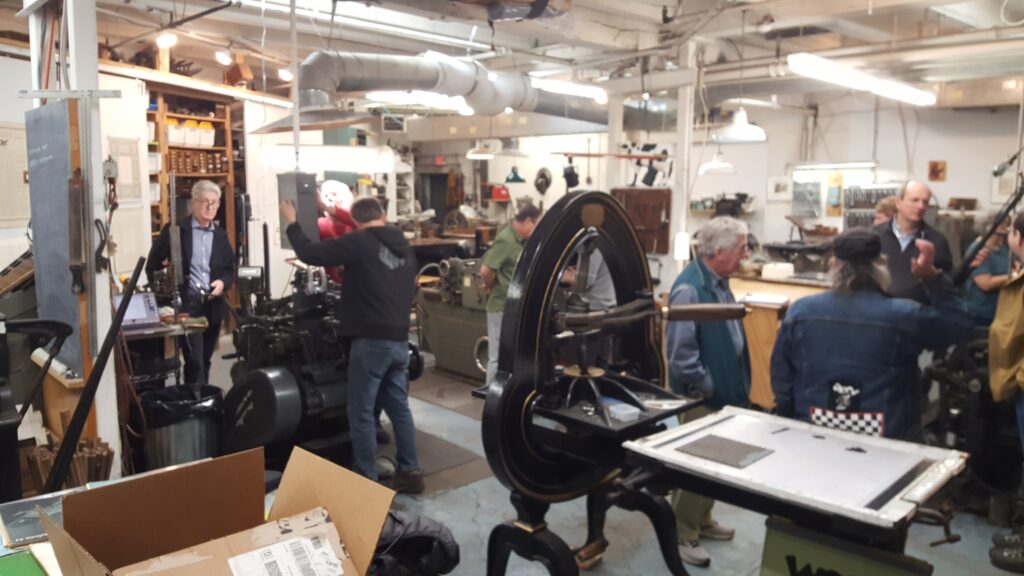
Some identifiable (to me) faces: Bill Welliver (brown jacket on right edge of photo) talking to Patrick Goossens, Steve Heaver in turquoise vest looking on, Bradley Hutchinson in green shirt partly hidden by the arch of the iron hand press.
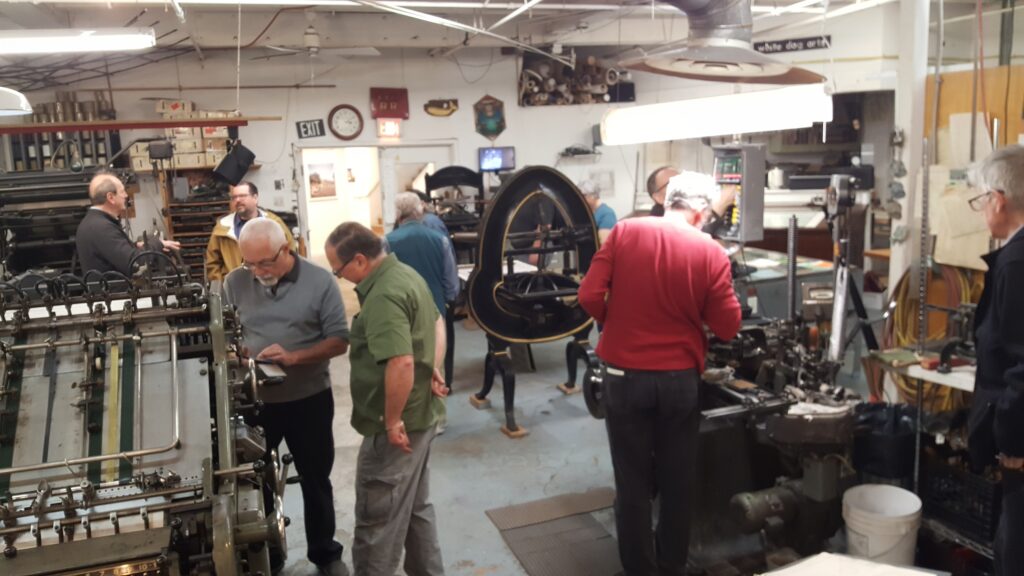
Left to right (sort of): Patrick Goossens talking with Bill Welliver, Dan Jones and Bradley Hutchinson consulting Dan’s phone, David Wolfe in the red shirt contemplating his caster.
Saturday evening saw us swamp the poor folks at at Nonesuch River Brewing. What started off as 8 or so people snowballed into a group of about 28. Fortunately the serving staff were troopers and managed to arrange seating for all of us together at three large tables, and we enjoyed a good dinner and more interesting beers.
Wolfe Editions was also the venue for Saturday. In the morning there was a tech session, which turned into a get-the-caster-working-again session. David Wolfe had just installed a second-hand but new-and-unused Welliver interface on his caster, but it appears that the previous owner might have opened up one of the air valves and lost some parts because one of the lines was always receiving air. This would make composition casting impossible, so we decided to just cast sorts from a large composition (16-point) matcase.
Even this apparently simple job caused problems: We were unable to set the quad, some letters cast almost a point too wide for no apparent reason.
As it turns out this caster is fitted with the Unit Adding attachment, and this was fitted with a distance piece, whose size was exactly the casting width error we observed. The leaking valve in the interface was causing this to engage in an irregular manner, and the attachment itself may have some defect. I later looked into the pneumatics for this attachment, and it seems that even with the selector valve set to the “OUT” (off) position, the actual distance pieces would still be inserted into the wedge mechanism when the 0.0075 air channel was selected, and this is the one that was leaking in the interface. We were unable to remove the distance piece by the normal procedure, and instead had to reach under the caster table and drop it out the bottom of the attachment, which is what makes me suspect some other defect is present. Later experiments showed that we could also not install the distance piece per instructions, so I suspect there is a burr, or a bit of type metal, or some misaligned part preventing proper operation of this attachment.
Then we noticed the pot was solidifying. With no voltmeter at hand we tried curing the problem by checking all the internal electrical connections to no avail. Eventually the problem showed itself as a blinding flash in David’s face revealing a broken wire touching its metal enclosure. The flexible conduit to the heaters, which moves when the pot is swung out, was loose at one end so all the flexing was concentrated in that one spot, and the wires therein were solid (not stranded) and so had initially broken from fatigue, stopping the heaters. Moving things a few more times while diagnosing allowed the broken end to pierce the insulation and touch the casing.
After the wire was repaired, the pot still did not work. It seems that the arc had blown a fuse, but there are at least three fuse panels and one circuit breaker involved, and our efforts at swapping fuses didn’t get things working. David eventually headed out to find his voltmeter at home, and failing that returned with a newly-purchased one. After a second outing to buy a battery for it we started tracing the power. We must have confused our fuse-swapping trials because the caster came on when we turned on the switch, and the voltmeter proved unnecessary.
By then it was into the afternoon and time for presentations so we didn’t really get to see the caster run.
After sandwiches for lunch, the afternoon saw presentations in the lobby outside Wolfe Editions. The presentations had been rescheduled from the original plan because several of the attendees had to leave Sunday afternoon and would have missed half the presentations on the original schedule. Unfortunately I didn’t take notes on the presentations so I can’t really give any details on them here.
The banquet was held at DeMillo’s On The Water, a ferry converted into a restaurant docked in the harbour. We had a long table and I was seated near the middle, and after dinner I took a couple of quick pictures looking down the table either way. I’m not going to try to identify everyone here.
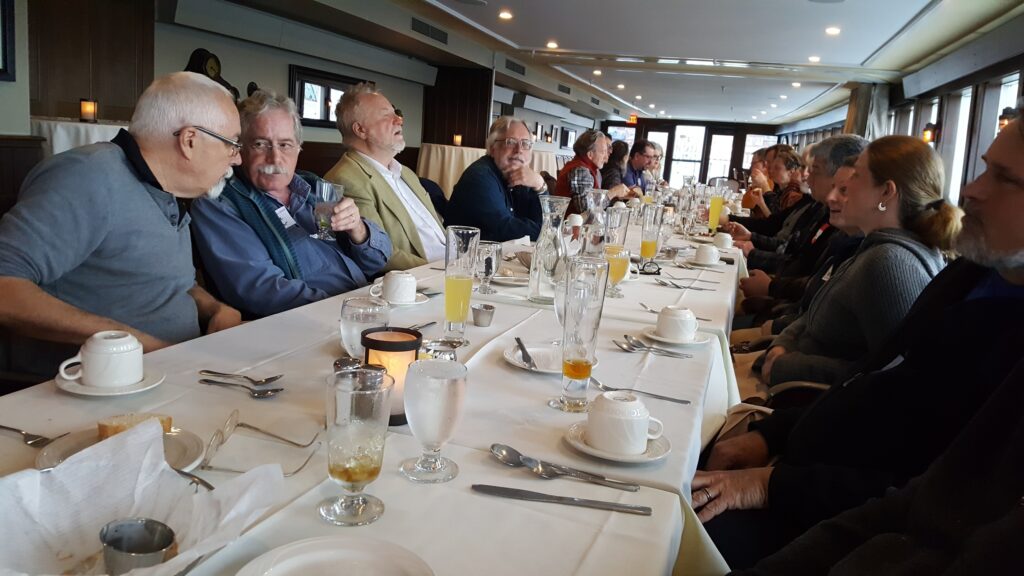
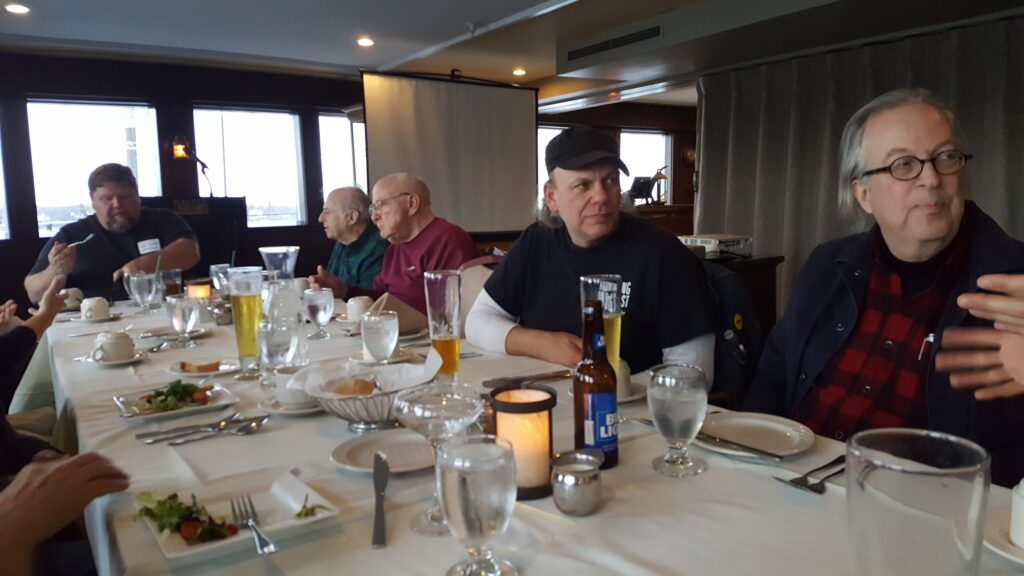 After dessert Rich Hopkins gave a presentation on some of the history of the ATF. Some photos from the early years had surfaced since the last conference and these were included in his talk.
After dessert Rich Hopkins gave a presentation on some of the history of the ATF. Some photos from the early years had surfaced since the last conference and these were included in his talk.
Sunday morning we met again at Wolfe Editions for the remaining presentations. These were followed by a group session for users of the Welliver computer interface.
After sandwiches for lunch, by the afternoon the folks who had to leave early were gone, and those remaining had the choice to hang around Wolfe Editions or drop by our other hosting location, Scott Vile’s Ascensius Press. I chose the latter, so I got to visit another interesting shop. I unfortunately took no photos here; the shop had a low ceiling so wide shots like I took at Wolfe Editions would not be possible.
Scott was trying to get his Supercaster to cast strip material but just could not come up with the correct combination of speed, temperature, pump adjustments, and phase of the moon to get it to work. Dan Jones was there as well and he feels that for strip material the alloy should be low on tin and antimony, even leaner that Linotype (eutectic) metal, for good strip casting.
On the other hand, I had the opportunity to try out my computer interface on John Kristensen’s comp caster. Although the pot was cold I could put the caster through all the motions and it worked flawlessly. At least the interface worked flawlessly: Although onlookers were somewhat amused to see this tangle of wires and breadboard bouncing up and down on top of the centering pin arm (I claim this is “stress testing”) I was more concerned about the way the entire galley and tool tray squirmed around visibly during a galley cycle. Ed Rayher and I looked into this and found that one of the screws holding the galley stand to the main stand was loose, and the slide for the line hook was stiff with old lubricant. Tightening the screw and some WD-40 on the slide cleared up the problem. I have mentioned to John that this slide needs some proper oil, since WD-40 will not last.
The group that had gathered at Ascensius Press convened again for dinner at the Portland Pie Company in Scarborough for more food and beer and a bit of a postmortem of the conference.
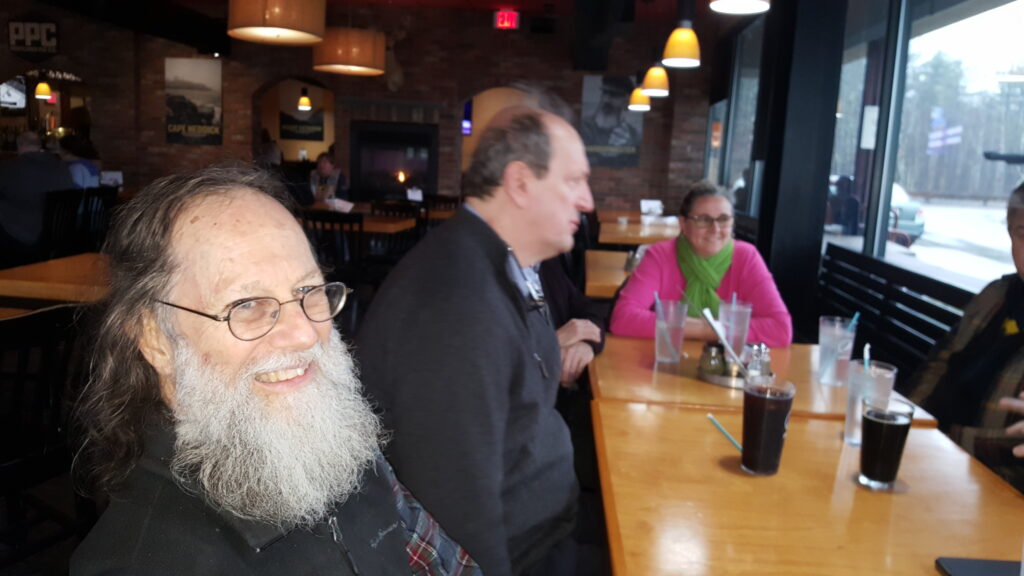
L-R: Ed Rayher, Patrick Goossens, David MacMillan (completely hidden behind Patrick), and his partner Kate at the head of the table.
The next morning I headed home via Quebec and Ontario (rather than through New York to Buffalo). This was a cross-Maine trip through several roads and turns, and my phone chose that day to stop providing cell data so I only had a rough Google Maps route through the state. One road was closed, I assume due to flooding with all the rain on Sunday, making my route even more poorly defined. I reasoned, though, that if I continued North and West and didn’t turn off onto any smaller roads I would eventually arrive at I-93. My only theory regarding my phone is that May 1st was the date AT&T actually pulled the plug on 3G service (my ancient phone can in theory do 4G but that might be a Bell Canada dialect incompatible with AT&T).

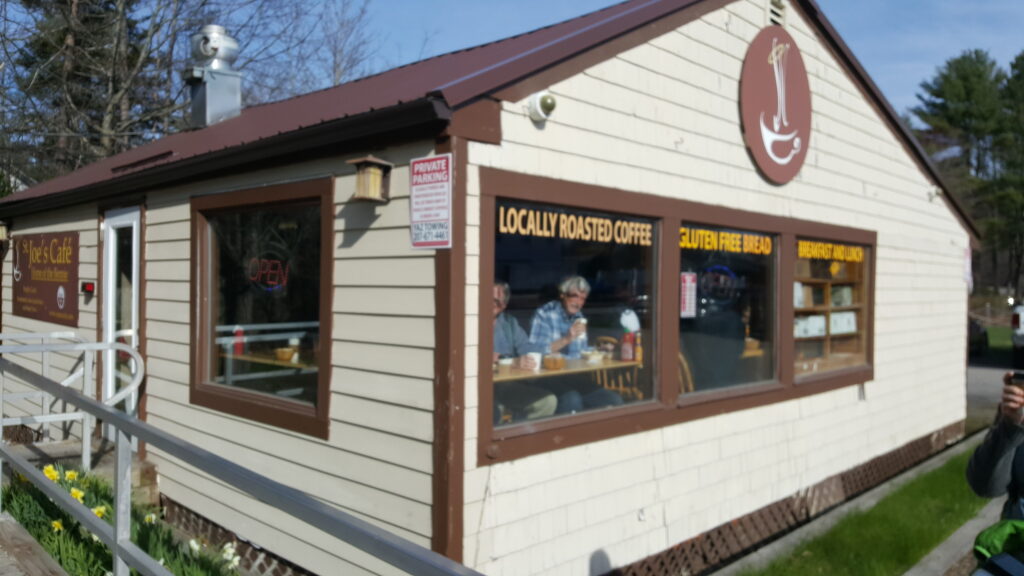

Leave a Reply